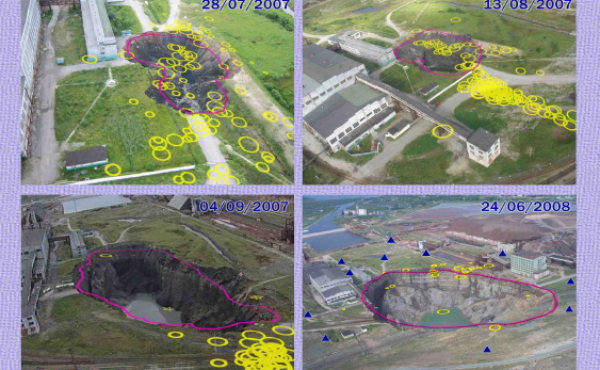To better understand the rockmass response to mining – specifically changes in stress and fracture density – it is desirable to accurately measure changes in the body wave velocities. Ideally this should be achieved over distances of at least 300 m with
resolution of 0.01% or better. Two approaches to this problem have been discussed here: the use of controlled seismic sources and ambient noise.
Three types of controlled seismic sources have been discussed: piezoelectric, rotating mass and pneumatic. The piezoelectric source produces hourly estimates of relative seismic velocity variation with an indicated resolution of around 1.3 × 10-3 using
a standard borehole geophone over a range of 80 m in a highly attenuating rock mass. The rotating eccentric mass source produces a very strong signal amenable to spectral analysis techniques, but requires a small phased array to separate the P- and S-waves, making this source less practical. The pneumatic source generates clear, repeatable signals with a signal-tonoise ratio equivalent to an hourly resolution of 5 × 10-5, and so is the best of the sources tested, although long-term reliability is unknown.
The ambient noise technique has been explored with a 3D numerical model of Beaconsfield mine (Australia). Recordings of noise in an underground mine was used as seismic sources in a few places in the mines, and synthetic seismograms generated.
This synthetic data was analysed using the ambient noise technique and shown to yield estimates of seismic velocity variations to a resolution of 10-4. Theoretically, a stable isotropic seismic radiation field is required for this, and in typical underground
mines noises are generated in only a few places, changing in time. However the scattering produced by tunnels and voids appears to generate a sufficiently isotropic field, even if only 30% of the noise sources are stable.
These results mean it is possible to accurately measure seismic velocity variations using both ambient and active source techniques using a standard geophone array. It should be possible to do this while simultaneously using the sensor array to
perform passive microseismic monitoring.
Equations expressing changes in Young’s modulus, E and Poisson’s ratio, v as functions of changes in P- and S-wave velocity have been derived. It appears that the elastic parameters, E and v are more sensitive to velocity variations than might be
expected, with changes in velocities producing larger changes in E and sometimes v . This result further highlights the need for accurate monitoring of seismic velocity changes.
Authors: R.A. Lynch, G. Olivier and M.T. Green Institute of Mine Seismology, Stellenbosch, Republic of South Africa
Link to download.
Lynch-Olivier-Green(2013)_High-Accuracy-Measurements-of-Seismic-Velocity-Variations-in-Mines





